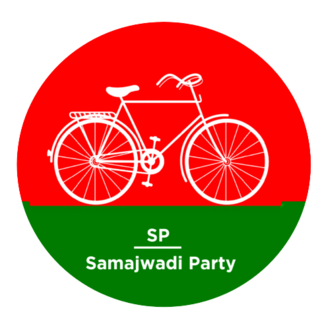
The Samajwadi Party is a socialist political party in India. It was founded on 4 October 1992 by former Janata Dal politician Mulayam Singh Yadav and is headquartered in New Delhi. The Samajwadi Party is currently led by former Chief Minister of Uttar Pradesh, Akhilesh Yadav. As of 2024, it is currently the third-largest political party in India, and the largest party in Uttar Pradesh.
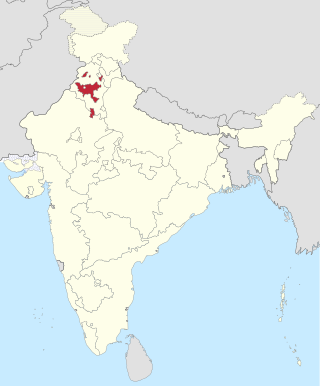
The Patiala and East Punjab States Union (PEPSU) was a state of India, uniting eight princely states between 1948 and 1956. The capital and principal city was Patiala. The state covered an area of 26,208 km2. Shimla, Kasauli, Kandaghat and Chail also became part of PEPSU.
The State Legislative Assembly, or Vidhana Sabha, is a legislative body in each of the states and certain union territories of India. In 22 states and 3 union territories, there is a unicameral legislature which is the sole legislative body. In 6 states, the legislative assembly is the lower house of their bicameral legislature with the upper house being the State Legislative Council. 5 union territories are governed directly by the Union Government of India and have no legislative body.

Elections in Kerala are regularly held to appoint government officials at various levels, both within the state of Kerala and in India as a whole. These elections encompass national elections as well as regional elections for local bodies and panchayats.

The Punjab Legislative Assembly or the Punjab Vidhan Sabha is the unicameral legislature of the state of Punjab in India. The Sixteenth Punjab Legislative Assembly was constituted in March 2022. At present, it consists of 117 members, directly elected from 117 single-seat constituencies. The tenure of the Legislative Assembly is five years unless dissolved sooner. The Speaker of the sixteenth assembly is Kultar Singh Sandhwan. The meeting place of the Legislative Assembly since 6 March 1961 is the Vidhan Bhavan in Chandigarh.

The Government of Gujarat, also known as GujaratGovernment, is the supreme governing authority of the Indian state of Gujarat and its 33 districts. It consists of an executive of the legislators appointed by the Governor of Gujarat, a judiciary and of a publicly elected legislative body.
The politics of Odisha are part of India's federal parliamentary representative democracy, where the union government exercises sovereign rights. Certain powers are reserved to the states, including Odisha. The state has a multi-party system, in which the two main parties are the nationalist Bharatiya Janata Party (BJP) and the regional, socialist Biju Janata Dal (BJD). The Indian National Congress (INC) has also significant presence.
State Governments of India are the governments ruling over the 28 states and 3 union territories of India with the head of Council of Ministers in every state being the Chief Minister. Power is divided between the Union government and the state governments.
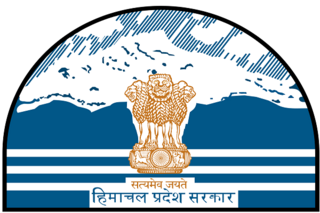
The Himachal Pradesh Legislative Assembly is the unicameral legislature of the Indian state of Himachal Pradesh. The seat of the Assembly is at Shimla, the capital of the state. There are 68 Members of Legislative Assembly, all directly elected from single-seat constituencies. Its term is 5 years, unless sooner dissolved.
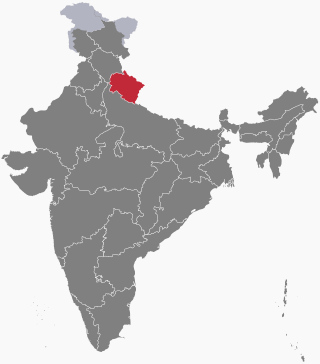
Elections for the Uttarakhand Legislative Assembly in Uttarakhand state, India are conducted in accordance with the Constitution of India. The legislative assembly of Uttarakhand creates laws regarding the conduct of local body elections unilaterally while any changes by the state legislature to the conduct of state level elections need to be approved by the Parliament of India. In addition, the state legislature may be dismissed by the Parliament according to Article 356 of the Indian Constitution and President's rule may be imposed.
The 1962 Punjab Legislative Assembly election was the Third Vidhan Sabha election of the state when the Indian National Congress emerged as the largest party with 90 seats in the 154-seat legislature in the election. The Shiromani Akali Dal became the official opposition, holding 16 seats. From 5 July 1966 to 1 November 1966, Assembly was under suspension.

The 1967 Punjab Legislative Assembly election was the Fourth Vidhan Sabha election of the state. This was the first hung assembly. Indian National Congress emerged as the largest party with 48 seats in the 104-seat legislature in the election. The Akali Dal - Sant Fateh Singh became the second, holding 24 seats. On 28 August 1968, Assembly dissolved prematurely and president rule was imposed.

The 1969 Punjab Legislative Assembly election was the fifth Vidhan Sabha election of the state. This was the second hung assembly. Shiromani Akali Dal emerged as the largest party with 43 seats in the 104-seat legislature in the election. The Indian National Congress became the second, holding 38 seats. On 13 June 1971, Assembly dissolved prematurely and president rule was imposed.

The 1972 Punjab Legislative Assembly election was the sixth Vidhan Sabha election of the state. Indian National Congress emerged as the victorious party with 66 seats in the 104-seat legislature in the election. The Shiromani Akali Dal became the official opposition, holding 24 seats. On 30 April 1977, Assembly dissolved and president rule was imposed.

The 1977 Punjab Legislative Assembly election was the seventh Vidhan Sabha election of the state. Shiromani Akali Dal and Janata Party coalition emerged as the victorious with 83 seats in the 117-seat legislature in the election. The Indian National Congress became the official opposition, holding 17 seats. On 17 February 1980, Assembly dissolved prematurely and president rule was imposed.

The 1980 Punjab Legislative Assembly election was the eighth Vidhan Sabha election of the state. Indian National Congress emerged as the victorious with 63 seats in the 117-seat legislature in the election. The Shiromani Akali Dal became the official opposition, holding 37 seats. On 6 October 1983, Assembly was placed under suspension and president rule was imposed and then dissolved on 26 June 1985.
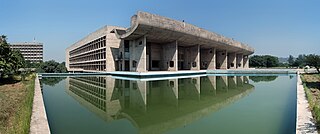
Election for the Sixteenth Legislative Assembly was held in the Indian state of Punjab. Polling was done on 20 February 2022 to elect the 117 members of the Punjab Legislative Assembly. The counting of votes declaration of results was done on 10 March 2022. The Fifteenth Punjab assembly was dissolved on 11 March 2022. The dissolution was necessitated after the results of the election was declared on 10 March. In the Sixteenth Punjab Legislative Assembly, 92 members of the ruling Aam Aadmi Party form the treasury benches. The main opposition party in the assembly is Indian National Congress with 18 seats. The other parties which are in opposition are the Shiromani Akali Dal, the Bharatiya Janata Party, the Bahujan Samaj Party and independents. AAP MLA, Kultar Singh Sandhwan was announced as the speaker of the assembly.

The Punjab Legislative Assembly or the Punjab Vidhan Sabha is the unicameral legislature of the state of Punjab in India. Sixteenth Punjab Legislative Assembly was constituted in March 2022. At present, it consists of 117 members, directly elected from 117 single-seat constituencies. The tenure of the Legislative Assembly is five years unless dissolved sooner. The current Speaker of the Assembly is Kultar Singh Sandhwan and Secretary of the Assembly is Mr. Surinder pal since April, 2021. The meeting place of the Legislative Assembly since 6 March 1961 is the Vidhan Bhavan in Chandigarh.














